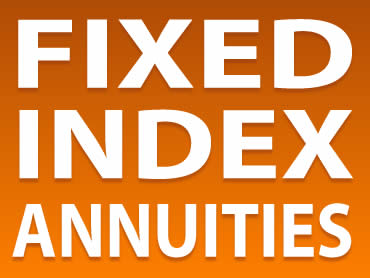Fixed Index Annuity Highlights
Sometimes referred to as equity-indexed annuities, fixed-indexed annuities are a combine some of the features of fixed and variable annuities. A fixed indexed annuity is a contract between yourself (the investor) and an insurance company, whereby the insurance company agrees to credit your contract with a return that’s based on the positive performance of an index such as the S&P 500 Composite Stock Price Index. Equity-indexed annuities also guarantee that the contract value will not be less than a specified minimum (regardless the performance of the index).

Equity indexed annuities have been one of the fastest-growing type of annuities over the last few years, accounting for about 30% of all annuity sales.
According to the Insured Retirement Institute, an FIA is a fixed annuity that credits a minimum guaranteed interest rate over a couple of years, plus additional interest that might be added based on the percentage change in the value of a popular market index.
How Fixed Indexed Annuities Work
When buying a fixed index annuity contract, you will be required to make a deposit (usually a single premium deposit payment, but flexible premiums are possible with some FIAs), and then choose an interest crediting strategy from about 4 or 5 index options. Interest will be credited to the annuity account based on the positive performance of the selected stock market index (typically S&P 500). However, insurance companies use participation rates and cap rates that limit the amount of interest that’s actually credited to your contract.
Participation/Index Rates
The participation rate refers to the increase (in percentage) in the index by which the contract will grow. The participation rate is usually less than 100% and will vary from one FIA to another based on the length and terms of the contract. Let’s say, for instance, that an insurance company sets the participation rate at 50% of the performance of the selected index. If the index returns 10% in a particular policy year, then only 5% (50% of 10%) is credited to the annuity.
Floor & Cap Rates
The equity indexed annuity floor is rather the minimum guaranteed amount hat’s credited to the annuity account. With most FIAs, the floor rate is usually 0-2%. The cap rate refers to the maximum percentage increase allowed for the contract each year. If the selected market index grows by 35%, and the cap rate is set at 10%, then only 10% is added to the contract. FIAs with longer surrender charge durations tend to have higher cap rates. Some fixed indexed annuity contracts do not have a cap rate, but these usually have a much lower participation rate.
Index Credit Method
How many interest crediting methods are available will vary from one equity indexed annuity product to the other. Below are the four most basic ones:
- Annual interest – with this strategy, change in the selected market index is measured annually.
- Point-to-point – the index reset (measuring) period is a number of years.
- Annual high water mark with lookback – the contract’s highest anniversary gain is used to compute the FIA’s gain.
- Monthly averaging – at the end of each contract year, the monthly index average is computed.
Fixed Index Annuity Fees
There are no upfront fees charged when purchasing an FIA. However, surrender charges may be imposed if your withdrawal money in excess of the free withdrawal threshold (usually 10% per year) within the surrender charge duration. Depending on the contract, the participation fees and caps can be onerous.
Fixed Indexed Annuities Regulation
By law, FIAs are considered to be fixed annuities and are not typically issued by prospectus (a detailed document explaining how the annuity works, risks involved, expenses and charges, etc.). Some FIAs may be registered with the FINRA (Financial Industry Regulatory Authority) or the SEC (Securities and Exchange Commission) and are thus only sold by prospectus. Only individuals with securities and insurance license are allowed to sell registered FIAs.
FIA Features
For an extra annual fee, some fixed indexed annuities offer a guaranteed lifetime withdrawal benefit (GLWB), which can help boost the withdrawal benefits.
Fixed Indexed Annuities Pros and Cons
Like any other financial investment product, fixed indexed annuities have pros and cons.
On the pro side, these types of annuities allow the investor upside participation when stock markets are climbing, while at the same time protecting from downsides with a guaranteed minimum return. To sum it up, an equity-indexed annuity has the potential to pay higher premiums than fixed annuities, and pose less risk compared to variable annuities.
On the con side, FIAs lack the simplicity of fixed annuities and tend to be much more complicated investment vehicles. Another potential con is that equity-indexed annuity products have participation and cap rates and only give you a portion of the market index returns.
Are Fixed Indexed Annuities the Right Choice for Me?
If you’ve decided that you want to reap the benefits of market returns, but do not want to accommodate all the risks and volatility associated with the stocks markets, you might want to consider equity-index annuity contracts. But make sure you thoroughly read through the terms and conditions of each product before you commit.
Questions to Ask Before Purchasing an FIA
- What is the guaranteed minimum investment return with this annuity product?
- What percentage of my investment will the FIA return over time?
- What market indices does the FIA track?
- How is the index’s return calculated?
- What percentage of the index’s growth is credited to my contract?
- What us the surrender charge period and charges?
- How well does the insurance carrier offering the fixed indexed annuity product rank?
- Would an MYGA (Multi-Year Guarantee Annuity) make a better alternative?
- Does the annuity offer an additional guaranteed income rider, what are the terms and fees?

